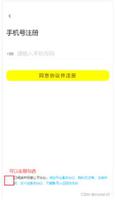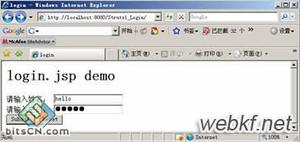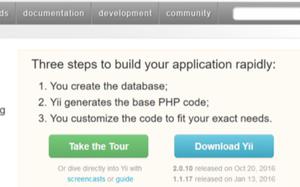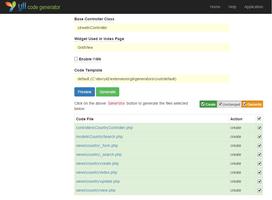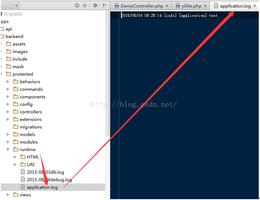Yii框架实现的验证码、登录及退出功能示例
本文实例讲述了Yii框架实现的验证码、登录及退出功能。分享给大家供大家参考,具体如下:
捣鼓了一下午,总算走通了,下面贴出代码。
Model
<?php
class Auth extends CActiveRecord {
public static function model($className = __CLASS__) {
return parent::model($className);
}
public function tableName() {
return '{{auth}}';
}
}
注:我的用户表是auth,所以模型是Auth.php
<?php
class IndexForm extends CFormModel {
public $a_account;
public $a_password;
public $rememberMe;
public $verifyCode;
public $_identity;
public function rules() {
return array(
array('verifyCode', 'captcha', 'allowEmpty' => !CCaptcha::checkRequirements(), 'message'=>'请输入正确的验证码'),
array('a_account', 'required', 'message' => '用户名必填'),
array('a_password', 'required', 'message' => '密码必填'),
array('a_password', 'authenticate'),
array('rememberMe', 'boolean'),
);
}
public function authenticate($attribute, $params) {
if (!$this->hasErrors()) {
$this->_identity = new UserIdentity($this->a_account, $this->a_password);
if (!$this->_identity->authenticate()) {
$this->addError('a_password', '用户名或密码不存在');
}
}
}
public function login() {
if ($this->_identity === null) {
$this->_identity = new UserIdentity($this->a_account, $this->a_password);
$this->_identity->authenticate();
}
if ($this->_identity->errorCode === UserIdentity::ERROR_NONE) {
$duration = $this->rememberMe ? 60*60*24*7 : 0;
Yii::app()->user->login($this->_identity, $duration);
return true;
} else {
return false;
}
}
public function attributeLabels() {
return array(
'a_account' => '用户名',
'a_password' => '密码',
'rememberMe' => '记住登录状态',
'verifyCode' => '验证码'
);
}
}
注:IndexForm也可以写成LoginForm,只是系统内已经有了,我就没有替换它,同时注意看自己用户表的字段,一般是password和username,而我的是a_account和a_password
Controller
<?php
class IndexController extends Controller {
public function actions() {
return array(
'captcha' => array(
'class' => 'CCaptchaAction',
'width'=>100,
'height'=>50
)
);
}
public function actionLogin() {
if (Yii::app()->user->id) {
echo "<div>欢迎" . Yii::app()->user->id . ",<a href='" . SITE_URL . "admin/index/logout'>退出</a></div>";
} else {
$model = new IndexForm();
if (isset($_POST['IndexForm'])) {
$model->attributes = $_POST['IndexForm'];
if ($model->validate() && $model->login()) {
echo "<div>欢迎" . Yii::app()->user->id . ",<a href='" . SITE_URL . "admin/index/logout'>退出</a></div>";exit;
}
}
$this->render('login', array('model' => $model));
}
}
public function actionLogout() {
Yii::app()->user->logout();
$this->redirect(SITE_URL . 'admin/index/login');
}
}
注:第一个方法是添加验证码的
view
<meta http-equiv="content-type" content="text/html;charset=utf-8">
<?php
$form = $this->beginWidget('CActiveForm', array(
'id' => 'login-form',
'enableClientValidation' => true,
'clientOptions' => array(
'validateOnSubmit' => true
)
));
?>
<div class="row">
<?php echo $form->labelEx($model,'a_account'); ?>
<?php echo $form->textField($model,'a_account'); ?>
<?php echo $form->error($model,'a_account'); ?>
</div>
<div class="row">
<?php echo $form->labelEx($model,'a_password'); ?>
<?php echo $form->passwordField($model,'a_password'); ?>
<?php echo $form->error($model,'a_password'); ?>
</div>
<?php if(CCaptcha::checkRequirements()) { ?>
<div class="row">
<?php echo $form->labelEx($model, 'verifyCode'); ?>
<?php $this->widget('CCaptcha'); ?>
<?php echo $form->textField($model, 'verifyCode'); ?>
<?php echo $form->error($model, 'verifyCode'); ?>
</div>
<?php } ?>
<div class="row rememberMe">
<?php echo $form->checkBox($model,'rememberMe'); ?>
<?php echo $form->label($model,'rememberMe'); ?>
<?php echo $form->error($model,'rememberMe'); ?>
</div>
<div class="row buttons">
<?php echo CHtml::submitButton('Submit'); ?>
</div>
<?php $this->endWidget(); ?>
同时修改项目下protected/components下的UserIdentity.php
<?php
/**
* UserIdentity represents the data needed to identity a user.
* It contains the authentication method that checks if the provided
* data can identity the user.
*/
class UserIdentity extends CUserIdentity
{
/**
* Authenticates a user.
* The example implementation makes sure if the username and password
* are both 'demo'.
* In practical applications, this should be changed to authenticate
* against some persistent user identity storage (e.g. database).
* @return boolean whether authentication succeeds.
*/
public function authenticate()
{
/*
$users=array(
// username => password
'demo'=>'demo',
'admin'=>'admin',
);
if(!isset($users[$this->username]))
$this->errorCode=self::ERROR_USERNAME_INVALID;
elseif($users[$this->username]!==$this->password)
$this->errorCode=self::ERROR_PASSWORD_INVALID;
else
$this->errorCode=self::ERROR_NONE;
return !$this->errorCode;
*/
$user_model = Auth::model()->find('a_account=:name',array(':name'=>$this->username));
if($user_model === null){
$this -> errorCode = self::ERROR_USERNAME_INVALID;
return false;
} else if ($user_model->a_password !== md5($this -> password)){
$this->errorCode=self::ERROR_PASSWORD_INVALID;
return false;
} else {
$this->errorCode=self::ERROR_NONE;
return true;
}
}
}
更多关于Yii相关内容感兴趣的读者可查看本站专题:《Yii框架入门及常用技巧总结》、《php优秀开发框架总结》、《smarty模板入门基础教程》、《php面向对象程序设计入门教程》、《php字符串(string)用法总结》、《php+mysql数据库操作入门教程》及《php常见数据库操作技巧汇总》
希望本文所述对大家基于Yii框架的PHP程序设计有所帮助。
以上是 Yii框架实现的验证码、登录及退出功能示例 的全部内容, 来源链接: utcz.com/z/313925.html


